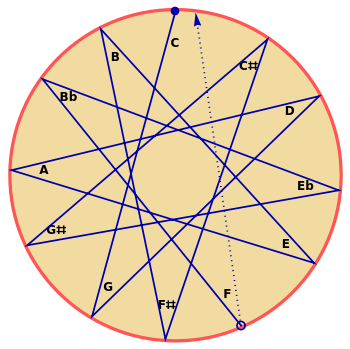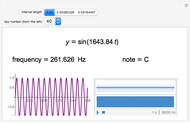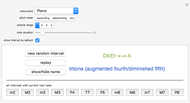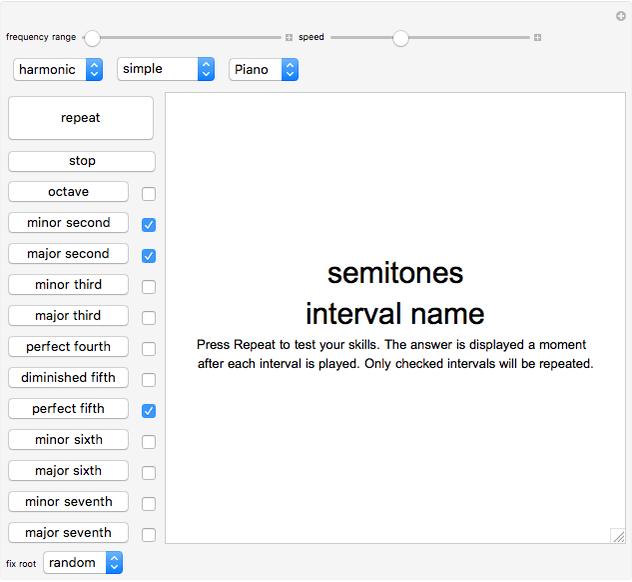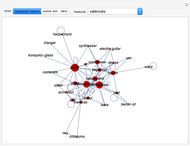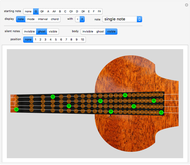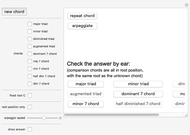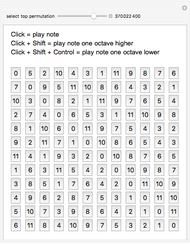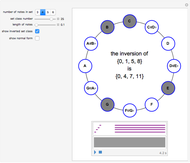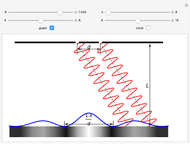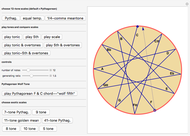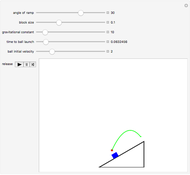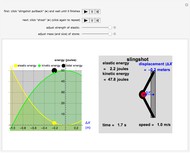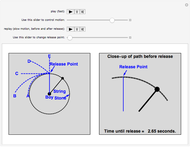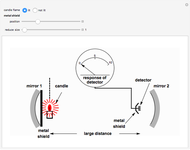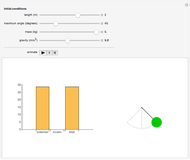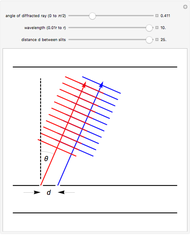Pythagorean, Meantone, and Equal Temperament Musical Scales

Requires a Wolfram Notebook System
Interact on desktop, mobile and cloud with the free Wolfram Player or other Wolfram Language products.
The Pythagorean scale is generated from just two integers (2 and 3). Multiplying the frequency of any tone by 2 produces the characteristic sound of an octave, and multiplying by 3 then dividing by 2 produces the characteristic sound of a "fifth" (the fifth tone in the diatonic scale: Do Re Mi Fa Sol). All of the 12 tones of the Pythagorean scale are produced by repeatedly multiplying by 3/2 until you reach a tone close to (but not the same as) an octave of the original. Visualizing the resulting "circle" of fifths in Mathematica reveals the beautiful structure and mathematical nature of the Pythagorean scale. You can also explore the structure and nature of other musical scales invented and used by musicians, tuners, composers, and mathematicians throughout musical history.
Contributed by: Emmanuel Amiot and Fernand Brunschwig (May 2008)
Open content licensed under CC BY-NC-SA
Snapshots
Details
A musical scale consists of several tones (usually 12) at well-defined intervals between a tonic and the octave (twice the frequency of the tonic). If all the tones are raised by one octave by multiplying their frequencies by 2, the new, higher tones have exactly the same musical and mathematical relationships with one another as before. As a result, a circle is a good way to visualize musical scales. If a dot at the top of the circle represents the tonic, an octave upward is represented by a full trip around the circle ( ) clockwise. All of the tones in the scale are plotted at points around the circumference, in the order of increasing pitch. The gradually increasing musical intervals between each tone and the tonic correspond to the gradually increasing distances along the circumference of the circle. The Pythagorean generating ratio of 3/2 produces a many-pointed "star", with each point of the star corresponding to a tone in the scale and each line between the points corresponding to a musical "step" between two of the tones. The small open circle at about five o'clock on the large circle represents the
) clockwise. All of the tones in the scale are plotted at points around the circumference, in the order of increasing pitch. The gradually increasing musical intervals between each tone and the tonic correspond to the gradually increasing distances along the circumference of the circle. The Pythagorean generating ratio of 3/2 produces a many-pointed "star", with each point of the star corresponding to a tone in the scale and each line between the points corresponding to a musical "step" between two of the tones. The small open circle at about five o'clock on the large circle represents the  , and final, tone in the scale. The dotted arrow represents the
, and final, tone in the scale. The dotted arrow represents the  step upward, using the exact 3/2 ratio, and slightly "missing" the starting tone. This illustrates visually the inevitable, enduring (and, to some, disappointing) truth about the Pythagorean scale: it does not "close".
step upward, using the exact 3/2 ratio, and slightly "missing" the starting tone. This illustrates visually the inevitable, enduring (and, to some, disappointing) truth about the Pythagorean scale: it does not "close".
This results from the mathematical fact that 3/2 and 2 are fundamentally incompatible. These two ratios can be multiplied by themselves as many times as you wish but can never be equal. In particular, multiplying 3/2 by itself twelve times ( ) produces almost (but not exactly) the same result as multiplying 2 by itself seven times (
) produces almost (but not exactly) the same result as multiplying 2 by itself seven times ( ). In fact, multiplying these two ratios by themselves will never produce an exact equality, which guarantees that generating tones via a "circle of fifths" will always "miss" the octave of the starting point.
). In fact, multiplying these two ratios by themselves will never produce an exact equality, which guarantees that generating tones via a "circle of fifths" will always "miss" the octave of the starting point.
Hint: If you hold down the Alt key (Windows) or Option key (Mac), the action of the slider will be slowed down by a factor of 20 relative to the movements of the mouse. For finer control press Windows Alt+Shift or Mac Option-Shift, and for the finest possible control press Windows Alt+Shift+Ctrl or Mac Option-Shift-Ctrl. Click the "+" just to the right of the sliders to reveal additional buttons to control them.
Snapshot 1: The 12-tone Pythagorean scale. All tones are separated by intervals of perfect fifths with the higher frequency exactly 3/2 times the lower frequency. The solid dot at the top represents the starting point (for example, "middle C"); the first step is a rotation of about  , clockwise around the circle, producing a new tone ("G") at about seven o'clock. The
, clockwise around the circle, producing a new tone ("G") at about seven o'clock. The  step is another rotation clockwise of about
step is another rotation clockwise of about  to "D" at about two o'clock. Nine more steps (a total of 11) produce all the other scale tones, up to the
to "D" at about two o'clock. Nine more steps (a total of 11) produce all the other scale tones, up to the  ("F", the small circle at about five o'clock). The dotted arrow shows that the
("F", the small circle at about five o'clock). The dotted arrow shows that the  step starting from the "F" goes beyond the starting tone (an octave of the original "C"). The result is that the interval between F and C in this scale is seriously out of tune. This was notorious among musicians and composers; it was known as the "wolf tone", due to its resembling the sound made by a howling wolf. Using the buttons, you can play the tonic and the perfect "fifth" (individually and together), as well as the wolf tone. Imagine how listeners in church would react to hearing the organist play a wolf tone in the middle of a beautiful hymn! Can you hear the difference between the sizes of the intervals when you play the scale? Compare the sounds of the intervals with the sizes of each interval represented in the Demonstration. The "distance" between neighboring points of the star should correspond with the musical intervals you hear between the tones as the scale is played.
step starting from the "F" goes beyond the starting tone (an octave of the original "C"). The result is that the interval between F and C in this scale is seriously out of tune. This was notorious among musicians and composers; it was known as the "wolf tone", due to its resembling the sound made by a howling wolf. Using the buttons, you can play the tonic and the perfect "fifth" (individually and together), as well as the wolf tone. Imagine how listeners in church would react to hearing the organist play a wolf tone in the middle of a beautiful hymn! Can you hear the difference between the sizes of the intervals when you play the scale? Compare the sounds of the intervals with the sizes of each interval represented in the Demonstration. The "distance" between neighboring points of the star should correspond with the musical intervals you hear between the tones as the scale is played.
Snapshot 2: The 12-tone equal temperament scale. This is the scale used in almost all of today's Western music. Since about 1800, the generating ratio has been adjusted (or "tempered") to a value just below 3/2 so that the scale "closes". As shown by the dotted arrow, the final step upward from the  tone ("F") lands exactly on "C", the starting tone. There is now no wolf tone. However, the ratios between the frequencies of all of the fifths are now very slightly smaller than the perfect 3/2 ratio. This means that all the intervals of the fifths are now very slightly out of tune. The buttons allow you to play the tonic and the fifth along with their
tone ("F") lands exactly on "C", the starting tone. There is now no wolf tone. However, the ratios between the frequencies of all of the fifths are now very slightly smaller than the perfect 3/2 ratio. This means that all the intervals of the fifths are now very slightly out of tune. The buttons allow you to play the tonic and the fifth along with their  and
and  "overtones". The overtones are additional sounds, almost always created by any vibration, which give musical tones their characteristic "quality" or "timbre". The overtones are usually softer than the original and have frequencies of two, three, four, etc. times the frequency of the original vibration. If you play the tonic and fifth chord with the overtones, you should be able to hear the "beats" produced by the very slight difference in frequency between the second overtone of the tonic (with three times its frequency) and the first overtone of the fifth (with two times its frequency). Does the star in the Demonstration show that the intervals between the tones change in size or that they are all the same? Can you hear any differences between the musical intervals when you play the scale?
"overtones". The overtones are additional sounds, almost always created by any vibration, which give musical tones their characteristic "quality" or "timbre". The overtones are usually softer than the original and have frequencies of two, three, four, etc. times the frequency of the original vibration. If you play the tonic and fifth chord with the overtones, you should be able to hear the "beats" produced by the very slight difference in frequency between the second overtone of the tonic (with three times its frequency) and the first overtone of the fifth (with two times its frequency). Does the star in the Demonstration show that the intervals between the tones change in size or that they are all the same? Can you hear any differences between the musical intervals when you play the scale?
Snapshot 3: The quarter-comma meantone temperament scale. This scale was developed in the Renaissance, starting in about 1500, partly to minimize the wolf tone. But the real impetus was to fix another problem in the Pythagorean scale—the fact that most of the thirds were at a ratio of two very large integers:  . The interval of
. The interval of  is much more musically consonant because of the smaller integers (5 and 4), so at about that time musicians and composers began insisting on using this interval for the thirds instead of the Pythagorean 81/64. In the quarter-comma meantone temperament scale, the generating ratio was reduced from the Pythagorean 3/2 just enough to have the thirds at a ratio of 5/4. You can explore the characteristics of this scale using the buttons of the Demonstration. Compare the generating ratios for the Pythagorean, the equal temperament, and the quarter-comma meantone scales. Do you expect the fifth interval in this scale to be "flat" (too narrow) or "sharp" (too wide)? Do you expect the fifth to be better in tune or further out of tune than in equal temperament? The Pythagorean scale, using a ratio of 3/2, "overshoots" the octave of the starting note. The equal temperament scale adjusts the ratio so as to hit the starting note exactly, neither "overshooting" nor "undershooting". Does the quarter-comma meantone scale "overshoot" or "undershoot" the starting tone? You can use the Demonstration to predict how the "beats" in the tonic-fifth chord of the quarter-comma meantone scale compare with those of the other scales. And you can test your prediction using your ears and this Demonstration!
is much more musically consonant because of the smaller integers (5 and 4), so at about that time musicians and composers began insisting on using this interval for the thirds instead of the Pythagorean 81/64. In the quarter-comma meantone temperament scale, the generating ratio was reduced from the Pythagorean 3/2 just enough to have the thirds at a ratio of 5/4. You can explore the characteristics of this scale using the buttons of the Demonstration. Compare the generating ratios for the Pythagorean, the equal temperament, and the quarter-comma meantone scales. Do you expect the fifth interval in this scale to be "flat" (too narrow) or "sharp" (too wide)? Do you expect the fifth to be better in tune or further out of tune than in equal temperament? The Pythagorean scale, using a ratio of 3/2, "overshoots" the octave of the starting note. The equal temperament scale adjusts the ratio so as to hit the starting note exactly, neither "overshooting" nor "undershooting". Does the quarter-comma meantone scale "overshoot" or "undershoot" the starting tone? You can use the Demonstration to predict how the "beats" in the tonic-fifth chord of the quarter-comma meantone scale compare with those of the other scales. And you can test your prediction using your ears and this Demonstration!
For additional information see Introductory Physics: A Model Approach,  edition, by Robert Karplus, 2003.
edition, by Robert Karplus, 2003.
Permanent Citation
